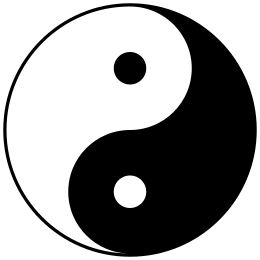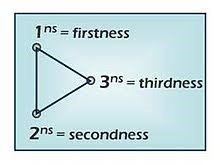Here you will find the precedents of the unicist evolutionary approach that allow establishing its context and understanding its essential functionality.
The unicist evolutionary approach erased the barriers between philosophy, science and action to deal with reality as a unified field using the Unicist Logic (double dialectical logic). It is based on the integration of Eastern and Western philosophies that requires using a superior abstraction and building a superior concretion. This gave birth to the Unicist ontological approach to complexity science to research and manage adaptive systems and environments.
Lao Tzu: The Tao Te Ching
Both the Unicist Double Dialectical Logic (Unicist Logic) and the TAO (pathway) deal with the principles that underlie nature.
The integration of Yin and Yang builds the triadic structure of the Unicist Logic. Both the TAO and the Unicist Logic explain the structure of the unified field of the functionality of a specific reality including its dynamics and evolution.
Tao gives birth to One,
One
gives birth to Two,
The
Two gives birth to Three,
The
Three gives birth to all universal things.
http://www.with.org/tao_te_ching_en.pdf
Chapter 42 of the Tao Te Ching

Yang is homologous to the dialectics between the purpose and the active principle. It defines the active functionality of an entity.
Yin is homologous to the dialectics between the purpose and the energy conservation principle. It defines the energy conservation functionality.
The conjunction of both dialectics is defined by a triadic structure that integrates the ultimate functional purpose of the entity with the active principle and with its complement, defined by the energy conservation principle.

Both the TAO and the Unicist Logic are based on the use of the conjunction “and” excluding the use of the exclusive disjunction “or”. If you are not aware of the scientific use of the TAO, we recommend reading the book “Tao of Physics” by Fritjof Capra.
Charles S. Peirce: Triadism and the Universal Categories
Merely to say that Peirce was extremely fond of placing things into groups of three, of trichotomies, and of triadic relations, would fail miserably to do justice to the overwhelming obtrusiveness in his philosophy of the number three.

Indeed, he made the most fundamental categories of all “things” of any sort whatsoever the categories of “Firstness,” “Secondness,” and “Thirdness,” and he often described “things” as being “firsts” or “seconds” or “thirds.”
For example, with regard to the trichotomy “possibility,” “actuality,” and “necessity,” possibility he called a first, actuality he called a second, and necessity he called a third.
Again: quality was a first, fact was a second, and habit (or rule or law) was a third. Again: entity was a first, relation was a second, and representation was a third. Again: rheme (by which Peirce meant a relation of arbitrary adicity or arity) was a first, proposition was a second, and argument was a third.
The list goes on and on. Let us refer to Peirce’s penchant for describing things in terms of trichotomies and triadic relations as Peirce’s “triadism.”

If Peirce had a general technical rationale for his triadism, Peirce scholars have not yet made it abundantly clear what this rationale might be.
He seemed to base his triadism on what he called “phaneroscopy,” by which word he meant the mere observation of phenomenal appearances.
He regularly commented that the phenomena in the phaneron just do fall into three groups and that they just do display irreducibly triadic relations.
He seemed to regard this matter as simply open for verification by direct inspection. https://plato.stanford.edu/entries/peirce/
Peter Belohlavek: The Ontogenetic Intelligence of Nature
Ontogenetic intelligence defines the basic laws of evolution. It is a set of what can be called natural laws which rule the evolution of living beings.
It was researched in order to find an approach to forecast and influence evolution.
Ontogenetic intelligence is defined by two principles of nature:
- The action and entropic principle that sustains growth and evolution. It is driven by freedom.
- The energy conservation principle, which sustains survival and avoids involution. It is driven by security.
In the field of human behavior, the action principle gives birth to the verbal function, which makes the fulfillment of purposes possible. The entropy produced by action produces changes in the goal of purposes.
To avoid changes and sustain the purpose, the energy conservation principle produces a homeostasis. The homeostatic value complements the purpose and ensures that action occurs within the established limits.
But the consequence of this interaction is never deterministic. The change produced by the interaction of the living being with the environment produces evolution or involution.
In nature, both principles sustain the evolution of living beings. Their effects can be observed in bacteria, viruses, cells, and other living beings.
At a more operational level, besides the expansion and contraction principles, there are functions that provide security and functions that provide freedom to living beings. These functions are implicit in the upper level functions (expansion – contraction).
Ontogenetic intelligence provides the basic rules to adapt to an environment. It sustains the living being’s unstable equilibrium. When, for any reasons, the ontogenetic intelligence is inhibited, the living being loses its equilibrium and its survival is endangered.
These principles are active in individual beings and in the live environment they are part of.
Integrating Philosophy, Science and Actions
As it is known, the management of complexity has been an unsolved challenge for sciences. This challenge was faced in 1976 by The Unicist Research Institute that was a pioneering organization in finding a structural solution for complexity without using artificial palliatives.
The final solution integrated philosophy, science and actions. It allowed managing complex environments as a unified field.
The objective of the Unicist Approach to Complexity Sciences developed by Peter Belohlavek was to find a scientific approach to understand nature and provide a structure to emulate it when designing, building or managing complex adaptive systems.
Belohlavek developed the epistemological structure for complexity sciences, by developing the unicist ontological methodology for complex systems research, which substituted the systemic approach to research adaptive systems and was materialized in the unicist double dialectical logical approach to deal with adaptiveness.
Learn more: https://www.unicist-school.org/complexity-sciences/ontogenetic-intelligence-of-nature/
Comparison between
Universal Categories and Unicist Concepts
Peirce’s triadic concepts describe the ontogenesis of universal categories’ knowledge while Belohlavek’s triadic concepts describe and define the ontogenesis, functionality, dynamics and evolution of adaptive entities whatever their kind.
| UNIVERSAL CATEGORIES Charles Sanders Peirce | UNICIST CONCEPTS Peter Belohlavek |
|
|---|---|---|
| Context | Philosophical Pragmatism | A Scientific pragmatic, structural, functionalist approach |
| Approach | Philosophical | Integrating philosophy, science and actions |
| What are they? | An account of universal knowledge | A representation of the universal functionality of complex adaptive systems |
| Types | Categories of processual existing | Intrinsic concepts (living beings) Extrinsic concepts (inanimate adaptive systems) |
| Purpose | Knowledge building | Functional Knowledge building and action guidance |
| Structure | Firstness Secondness Thirdness | Each concept is integrated by a triadic structure of fundamentals, which are subconcepts that have the same structure. These fundamentals ground the root causes of the functionality of a complex adaptive system based on the functional value they have in the environment. |
| Functionality | They describe what “feelings” are and their operationality. | They describe what “things” are, their functionality, dynamics and evolution |
| Intrinsic functionality | Each category is treated as universal and operational knowledge in the formation of ideas and concepts | The structure of essential concepts and their derived types of concepts is universal, but the value of the fundamentals is environment dependent |
| Specificity | Universal | 1. World of Physics: Purpose – Active and entropic function – Energy conservation function 2. Social world: Taboo – Utopia – Myth 3. World of ideas: Thesis – Antithesis – Homeostasis 4. Abstract world: Central value – Antithetic value – Homeostatic value 5. Semantic world: Substantive function – Verbal function – Adverbial function 6. Organizational world: Purpose – Procedure – Action guide 7. Productive world: Focus – Driver – Entropy Inhibitor |
| Relationship within the structure | Logic based, a normative logic of to ascent from substance to being in subject-predicate copula, and the prescension to ground | Based on the application of the complementation and supplementation laws, which can be complete or incomplete and operational or essential. |
| Integration | By the conjunction “and” | By the conjunction “and” and the definition of a functionality zone (in the case of living beings) or a credibility zone (in the case of inanimate systems) |
| Reach of validity | Universal | Universal |
| Origination | Ontogenesis of the specific universal knowledge | Ontogenesis of the functionality of complex adaptive systems |
| Subcategories | None | Preconcepts, Operational concepts, Functional concepts, Essential concepts, Mental concepts, Anticoncepts |
| Utility | Provide reliable universal knowledge suited to fix belief (the removal of doubt) | Provide the functional structure of adaptive environments to diagnose, develop strategies and define actions. |
| Use | The clarification of ideas and the fixation of belief | Build forecasts of adaptive environments and develop maximal and minimum strategy actions to ensure the achievement of results. |
| Applicability | Hypothetical Possibilities and probabilities | Managing adaptive systems and environments in the real world |
| Logical background | None | Unicist Logic – Double dialectical logic |
| Validation of knowledge building | Through observation and the use of logic | Using the double dialectical logic and its application to non-analogous or homologous fields and forecasting their evolution |
| Validation of their use | Hypothetical validation | Using destructive tests |
| Adaptiveness | None - It is a static structure of essential knowledge | Based on the unicist evolution and involution laws |
| Language | Philosophical” and scientific language | Scientific, plain language and Unicist Standard Language |
The Unicist Research Institute



